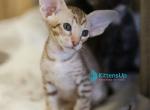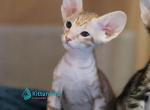

Peterbald Cat Breed Description
Peterbald Traits At A Glance
Active
Playful
Requires Attention
Affectionate
Vocal
Docile
Intelligent
Health
Grooming
Child Friendly
Pet Friendly
Size: Peterbald cats are medium in size, ranging in weight from 7 to 14 pounds.
Characteristics: While many Peterbald cats have the signature hairless appearance, it is possible to breed Peterbalds that appear to be a completely normal kitten with hair. In a single litter of cats each cat may have a varying degree of coat. An ultrabald Peterbald has no coat as well as no whiskers or eyebrows. A chamois Peterbald is relatively hairless but may have small patches or tufts of hair in different areas of its body. A velour Peterbald as a very short, very fine coat that they may or may not retain over their lifetime.
Finally, the brush or straight variety of Peterbalds may look like any other kind of cat with a typical coat and some have a wiry, unrefined coat -that is slightly wild and messy looking. With this coat type the cat may or may not retain it over its lifetime as well so with any variety, even if they start out having hair, they may lose it over time and appear to be hairless. Beyond their unique coat, the Peterbald's medium build, long body and broad chest and on full display for anyone to see. Peterbald cats have a triangular shaped head that has very large, pointed ears perched atop it. Their large, almond eyes will peer into your soul and their long, skinny tail whips around freely.
Temperament: While the Peterbald's hairless appearance can sometimes give it a more fierce appearance, it is actually one of the sweetest of most friendly cat breeds. Affectionate and energetic, they will be the first to greet you at the door and warmly invite you to play or cuddle. Because they love their humans so much they tend to follow them around and want to be with them whenever possible. They make a wonderful addition to any family because they are so friendly with everyone in the home including children and other animals and they love play, games and puzzles. Peterbalds are highly social so they do not like to be left alone for long periods of time and will demand your attention if they feel neglected. Additionally, they will happily vocalize with you and tend to be quite chatty with their loud, raspy voices.
Care: The Peterbald cat breed, like other hairless cat breeds, tends to be a little more high maintenance than other cat breeds. Not because they require an immense amount of brushing or combing like other breeds might need but because hairless cats can get cold very easily. They need to be kept warm and should avoid outdoor cold weather. They should also strictly be an indoor cat because they are prone to sunburns.
Coat: The coat of the Peterbald is one of its most unique and eye-catching features because most appear to have no coat at all. Peterbalds can have four kinds of coat: ultrabald, chamois or flock, velour, and brush and straight that are varying lengths. Because of their coat, they require an indoor life.
Origin: There have been many hairless cat breeds over time but the Peterbald cat breed is a relatively new one. While they may look related, the Peterbald cat breed is actually unrelated to the Sphynx cat breed and the gene that controls their hairlessness is actually different in each breed. To date, there are still studies underway to determine what exact genetic process is influencing hairlessness in Peterbald cats and there is hopes that the answer may soon be here.
The Peterbald cat breed is descended from the Russian Don Hairless when, in 1994, a Russian Don Hairless was mated with an Oriental Shorthair cat as an experiment. This experiment resulted in a litter of kittens and one kitten, Nocturne Iz Marino, would become the father of the Peterbald breed that we know today. In fact, every single Peterbald in existence today is a genetic descendent of Nocturne Iz Marino. To widen the gene pool, Peterbald cats are bred to Russian Blues and Siamese cats. In 2005, TICA (The International Cat Association) accepted the Peterbald breed for Championship status. Then, in 2009, the ACFA (American Cat Fanciers Association) granted the breed Championship status as well.


